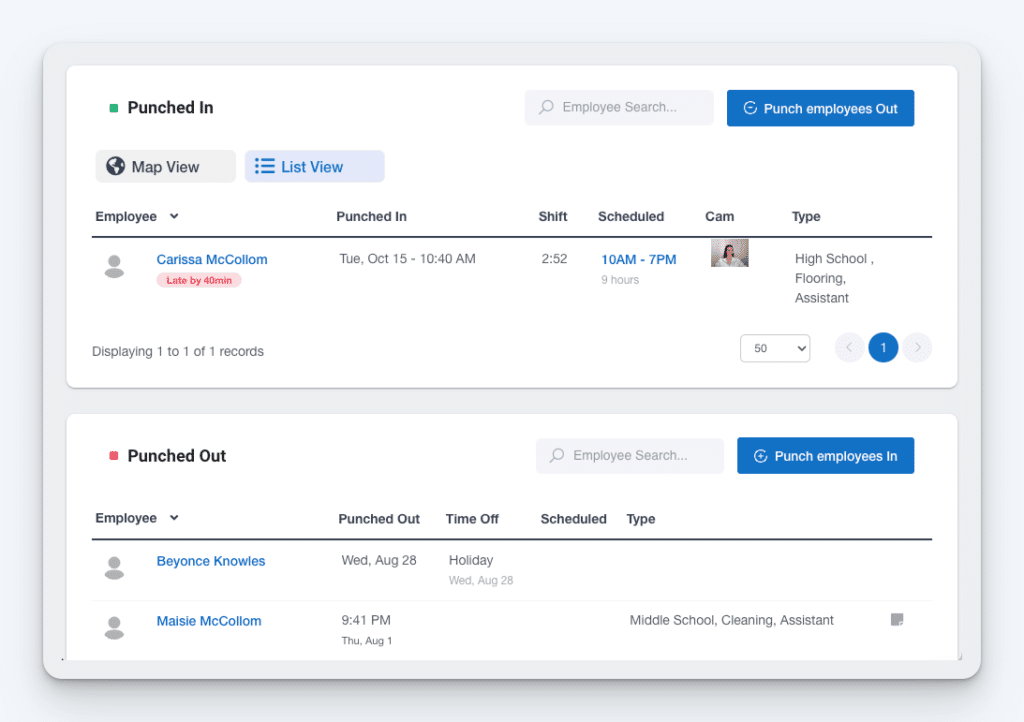How to Calculate Work Hours + Free Work Hours Calculator
Find out how to calculate work hours in 6 steps, use our free calculator, and discover an easier way to total up the hours employees worked.

If your business uses paper timesheets or punch cards to track employees’ hours, you’ll have to learn how to calculate work hours in order to determine how much to pay your employees. In this guide, we’ll walk you through a six-step process for calculating work hours, offer a couple of calculators to make the job easier, and introduce you to a better way to track employees’ hours and calculate their pay.
The downsides of calculating work hours manually
Calculating work hours isn’t hard. You just need basic math skills to be able to do it. However, it is time consuming, tedious, and error-prone. The time you spend calculating hours for payroll is often better spent on tasks that would help you grow your business or increase your profitability, and you can easily make mistakes when calculating that lead to payroll errors that require even more time to fix.
For most businesses, using employee time clock software like Buddy Punch is a far better solution than calculating hours manually. Buddy Punch lets employees clock in and out using a computer, tablet, or mobile phone. That data is automatically compiled into timesheets with regular hours, overtime hours, and pay calculated for you automatically. And you can easily download that data in reports to send to payroll.
How to calculate work hours: 6-step process
To calculate work hours for employees (or for yourself if you’re an employee), follow these six steps.
1. Record start and end times for shifts
Calculating work hours starts with recording the start and end times for all employees for all shifts they work over the course of a pay period. You can doing this using a manual punch clock, printable timesheets, or an Excel or Google Sheets spreadsheet.
2. Convert hours into military time
Converting hours into military time makes it easier to determine the total number of hours worked. It uses a 24-hour scale for referring to specific hours of the day, so instead of having both 1 a.m. and 1 p.m., 01:00 represents 1 a.m. and 13:00 represents 1 p.m.
To convert your time into military time, keep the morning hours the same, but add 12 hours to everything starting from 1 p.m. to midnight (12 a.m. can be reported as 00:00 or 24:00). Alternatively, you can use the military converter below:
Time Converter
You want to convert your start time and end time into military time so it’s easy to calculate the number of hours worked later through subtraction. As an example: say an employee worked from 8 a.m. to 5 p.m. In military time, that’s 08:00 to 17:00. To calculate the total hours for the day, all you need to do is subtract 8 from 17 to find out that the total hours worked was 9.
This is particularly helpful when employees don’t clock in and out exactly on the hour. Subtracting 08:13 from 17:34 is a lot easier than trying to figure out how many hours and minutes are between 8:13 a.m. and 5:34 p.m.
3. Subtract start times from end times
With hours all converted into military times, you can subtract start times from end times to get the total number of hours an employee worked per day. Say an employee worked from 8:30 a.m. to 4:47 p.m. Subtract 830 from 1647 to get 817, or 8 hours and 17 minutes (1647-830 = 817).
4. Subtract unpaid break times
If your employees take breaks that they’re not paid for, such as a 30-minute lunch, you’ll want to subtract those minutes from the total you came to in the last step to get the employee’s total paid hours for the day. If your employee worked eight hours and 47 minutes, subtract 30 from 847 to get 817 (eight hours and 17 minutes) — the total number of hours and minutes they need to be paid for.
5. Convert time into decimals
Next, you’ll want to convert hours into a decimal format so that it’s easy to add up hours across a pay period. To convert your work hours into decimals, you keep your hour number the same and divide your minute number by 60, then add the result to the hour number.
As an example, say an employee worked 7 hours 45 minutes. Divide 45 by 60, to get 0.75. Then, add that to 7 to arrive at a total of 7.75 hours in decimal format.
6. Add up all hours for the pay period
Once you have all of an employee’s hours totaled up in decimal format for the days they worked over a pay period, you simply add those numbers together to determine the total hours worked that you need to pay them for. So if an employee worked five days — 3.65 hours on day one, 11.45 hours on day two, 5.89 hours on day three, 6.47 hours on day four, and 3.78 hours on day five — add those all together:
3.65 + 11.45 + 5.89 + 6.47 + 3.78 = 31.24 total hoursFor this employee, you’ll want to pay them for the 31.24 hours they worked during the pay period.
Calculating the employee’s pay is another exercise entirely. You can learn more about how to calculate employee pay in our guides covering how to calculate wages and how to calculate overtime pay.
Repeat steps one through six for each of your employees to calculate the number of work hours you need to pay each employee for working for each of your pay periods.
A simpler way to calculate work hours
As you can see, calculating work hours is a lot of work. One way to make it easier is to use a time card calculator that lets you enter start and end times for each employee over a pay period and calculates total hours and pay for you. Another is to use a time tracking spreadsheet that’s set up with complex formulas that do the math for you.
However, the easiest way to calculate work hours for your team by far is to use software like Buddy Punch or one of our other recommended time card apps.

Buddy Punch is an employee time tracking system that works on computers, tablets, and mobile phones. It automatically calculates employee hours for you — and does a lot more than that:
- To-the-minute time tracking: Buddy Punch captures the exact amount of time employees work by collecting timestamps when employees clock in and out. Timesheets are populated automatically and can be edited if needed to fix errors like missed punches.
- Employee accountability: Buddy Punch helps prevent time theft with accountability features like GPS tracking, geofencing, IP address locking, photos on punch, facial recognition, and more.
- Team scheduling: With Buddy Punch, you can create work schedules in minutes, ensuring shifts are adequately covered and that your staff knows exactly when they’re scheduled to work.
- Payroll software and integrations: You can run payroll right within Buddy Punch or integrate Buddy Punch with your current payroll provider. Either way, using Buddy Punch helps simplify payroll and gets your team paid on time.
And this just scratches the surface of all of the ways that Buddy Punch can save your business time and money. View a complete list of its features here, or use the links below to try it our for yourself or get a demo.
Learn more about Buddy Punch
- Start a free trial — no credit card required
- View pricing
- Watch a video demo
- Take an interactive product tour
- Request a personalized demo
Get started calculating work hours
Calculating work hours manually takes time and can lead to mistakes. Following a step-by-step process helps, but using a reliable tool makes it even easier. Instead of spending hours adding up timesheets, you can use a simple calculator or, better yet, time tracking software like Buddy Punch. It automates the entire process, ensuring accuracy and saving you valuable time.
Try Buddy Punch today to simplify work hour tracking and payroll management for your business.



